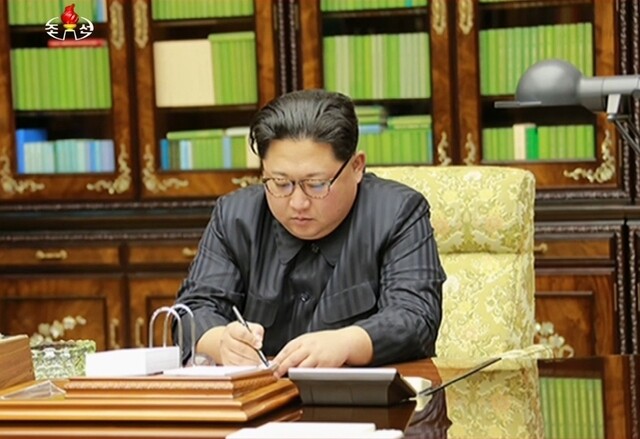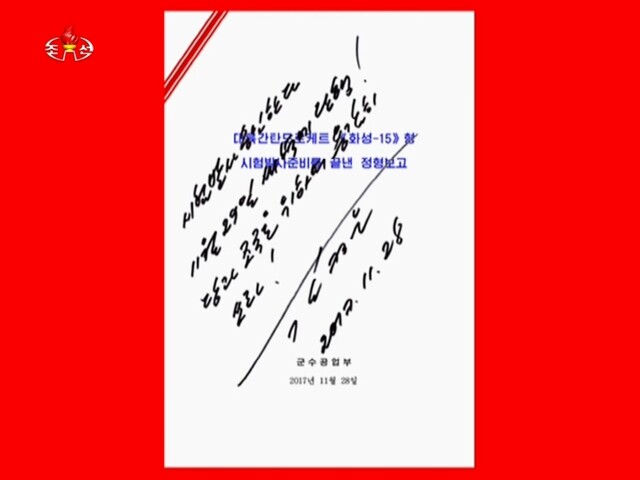hankyoreh
Links to other country sites 다른 나라 사이트 링크
[Editorial] Latest missile launch shows US and North Korea remain on crash course

North Korea launched a long-range missile believed to be an intercontinental ballistic missile (ICBM) early in the morning on Nov. 29. In a government statement around midday, North Korea declared the achievement of “completion of state nuclear force,” claiming a “test launch of the Hwasong-15 intercontinental ballistic rocket was successfully carried out.” The lack of any major nuclear or missile activity from North Korea for the 75 days after its Sept. 15 launch of the intermediate-range ballistic missile (IRBM) Hwasong-12 had raised hopes at one point that the tide may have turned toward dialogue. These feeble hopes were ruthlessly smashed by the ICBM launch. There are simply no words that can justify this provocation in launching this ICBM against the international community’s hopes for the Korean Peninsula’s denuclearization.
When we look at things objectively, however, the launch was not entirely unexpected. Not only were no obvious breakthroughs made in US President Donald Trump’s Asia tour or Chinese Communist Party International Liaison Department head Song Tao’s visit to the North as a special envoy for Chinese President Xi Jinping, but the Trump administration also moved to re-designate North Korea for the first time in nine years as a state sponsor of terrorism. While the latest launch does appear to follow Pyongyang’s own timetable for achieving “complete nuclear armament,” the re-designation may have also offered it some rationale.
“Maximum pressure” from US unlikely to rein in North Korea
It seems obvious that Pyongyang and Washington are going to remain on course for a head-on collision like two equally formidable runaway trains. Trump announced the same day that he has no plans to alter his administration’s approach of using sanctions and pressure against the North. Plans for increased sanctions were reportedly scheduled for discussion at an emergency UN Security Council meeting convened on Nov. 29. The problem is that it is unclear how the current sanctions could even be increased, or whether North Korea would capitulate and agree to dialogue if they were.
The Trump administration appears likely to press hard for a halt or large-scale reduction in Chinese crude oil supplies, but it is uncertain how positively Beijing will respond. Some are also predicting US shows of military force will become more frequent or intense. The goal may be to send a stern warning to the North, but there’s also a considerable economic and military burden South Korea will have to shoulder in the process.
Under the Barack Obama administration, the US stuck to a “strategic patience” approach toward North Korea; the Trump administration has focused on powerful sanctions. Stern condemnations and announcements of sanctions have followed each North Korean missile test like programmed machinery. Yet Pyongyang has continued to develop nuclear weapons and missiles even with the sanctions, and now claims to have achieved complete nuclear armament. This policy approach of international pressure – all sanctions with none of the “maximum engagement” promised – can more or less be called a failure, at least so far.

South Korean government must find “creative alternatives” amid crisis management
It’s time now for us to put our heads together and find other options. At a National Security Council (NSC) meeting called soon after North Korea’s missile launch, South Korean President Moon Jae-in ordered “stern sanctions and pressure” and “stronger military capacities.” At the same time, he also said he would “manage the situation so intensified tensions do not lead to an unfortunate situation,” while stressing the need to “prevent the US from considering a preemptive strike.” It appears to be a difficult situation where Seoul must step up cooperation with Washington on one hand while combating military tensions on the other – and all of this with the Pyeongchang Olympics a little over two months away.
Seoul’s first priority should be on doing everything it can to manage the crisis and prevent tensions on the peninsula from getting out of hand – on the understanding that however bad the situation gets, another war is out of the question. It should also keep itself open to the possibility that things may suddenly change, working to develop creative alternatives to open the door to dialogue with Pyongyang. In the end, the North Korean nuclear crisis can only be solved through negotiation.
Please direct questions or comments to [english@hani.co.kr]

Editorial・opinion
![[Guest essay] The real reason Korea’s new right wants to dub Rhee a founding father [Guest essay] The real reason Korea’s new right wants to dub Rhee a founding father](https://flexible.img.hani.co.kr/flexible/normal/500/300/imgdb/original/2024/0423/8317138574257878.jpg) [Guest essay] The real reason Korea’s new right wants to dub Rhee a founding father
[Guest essay] The real reason Korea’s new right wants to dub Rhee a founding father![[Column] ‘Choson’: Is it time we start referring to N. Korea in its own terms? [Column] ‘Choson’: Is it time we start referring to N. Korea in its own terms?](https://flexible.img.hani.co.kr/flexible/normal/500/300/imgdb/original/2024/0423/3617138579390322.jpg) [Column] ‘Choson’: Is it time we start referring to N. Korea in its own terms?
[Column] ‘Choson’: Is it time we start referring to N. Korea in its own terms?- [Editorial] Japan’s rewriting of history with Korea has gone too far
- [Column] The president’s questionable capacity for dialogue
- [Column] Are chaebol firms just pizza pies for families to divvy up as they please?
- [Column] Has Korea, too, crossed the Rubicon on China?
- [Correspondent’s column] In Japan’s alliance with US, echoes of its past alliances with UK
- [Editorial] Does Yoon think the Korean public is wrong?
- [Editorial] As it bolsters its alliance with US, Japan must be accountable for past
- [Guest essay] Amending the Constitution is Yoon’s key to leaving office in public’s good graces
Most viewed articles
- 1Samsung barricades office as unionized workers strike for better conditions
- 2[Editorial] Japan’s rewriting of history with Korea has gone too far
- 3[Column] The president’s questionable capacity for dialogue
- 4[Reporter’s notebook] Did playing favorites with US, Japan fail to earn Yoon a G7 summit invite?
- 5[Column] The clock is ticking for Korea’s first lady
- 6Korean government’s compromise plan for medical reform swiftly rejected by doctors
- 7[Column] Are chaebol firms just pizza pies for families to divvy up as they please?
- 8Why Korea shouldn’t welcome Japan’s newly beefed up defense cooperation with US
- 9[Column] Has Korea, too, crossed the Rubicon on China?
- 10US overtakes China as Korea’s top export market, prompting trade sanction jitters